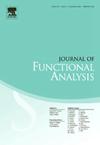The spectral gap of a Gaussian quantum Markovian generator
IF 1.6
2区 数学
Q1 MATHEMATICS
引用次数: 0
Abstract
Gaussian quantum Markov semigroups are the natural non-commutative extension of classical Ornstein-Uhlenbeck semigroups. They arise in open quantum systems of bosons where canonical non-commuting random variables of positions and momenta come into play. If there exists a faithful invariant density we explicitly compute the optimal exponential convergence rate, namely the spectral gap of the generator, in non-commutative spaces determined by the invariant density showing that the exact value is the lowest eigenvalue of a certain matrix determined by the diffusion and drift matrices. The spectral gap turns out to depend on the non-commutative space considered, whether the one determined by the so-called GNS or KMS multiplication by the square root of the invariant density. In the first case, it is strictly positive if and only if there is the maximum number of linearly independent noises. While, we exhibit explicit examples in which it is strictly positive only with KMS multiplication. We do not assume any symmetry or quantum detailed balance condition with respect to the invariant density.
高斯量子马尔可夫发生器的谱隙
高斯量子马尔可夫半群是经典Ornstein-Uhlenbeck半群的自然非交换扩展。它们出现在玻色子的开放量子系统中,其中位置和动量的正则非交换随机变量起作用。如果存在忠实不变密度,我们显式地计算由不变密度确定的非交换L2空间中最优指数收敛率,即发生器的谱间隙,表明精确值是由扩散矩阵和漂移矩阵确定的某个矩阵的最低特征值。谱间隙取决于所考虑的非交换L2空间,无论是由所谓的GNS还是KMS乘以不变密度的平方根决定的。在第一种情况下,当且仅当存在最大数量的线性无关噪声时,它是严格正的。然而,我们展示了明确的例子,其中它是严格的正只有KMS乘法。我们不假设关于不变密度的任何对称性或量子详细平衡条件。
本文章由计算机程序翻译,如有差异,请以英文原文为准。
求助全文
约1分钟内获得全文
求助全文
来源期刊
CiteScore
3.20
自引率
5.90%
发文量
271
审稿时长
7.5 months
期刊介绍:
The Journal of Functional Analysis presents original research papers in all scientific disciplines in which modern functional analysis plays a basic role. Articles by scientists in a variety of interdisciplinary areas are published.
Research Areas Include:
• Significant applications of functional analysis, including those to other areas of mathematics
• New developments in functional analysis
• Contributions to important problems in and challenges to functional analysis

 求助内容:
求助内容: 应助结果提醒方式:
应助结果提醒方式:


